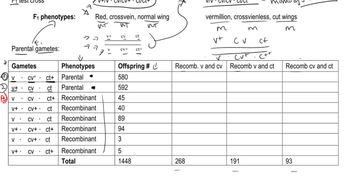Table of contents
- 1. Introduction to Genetics51m
- 2. Mendel's Laws of Inheritance3h 37m
- 3. Extensions to Mendelian Inheritance2h 41m
- 4. Genetic Mapping and Linkage2h 28m
- 5. Genetics of Bacteria and Viruses1h 21m
- 6. Chromosomal Variation1h 48m
- 7. DNA and Chromosome Structure56m
- 8. DNA Replication1h 10m
- 9. Mitosis and Meiosis1h 34m
- 10. Transcription1h 0m
- 11. Translation58m
- 12. Gene Regulation in Prokaryotes1h 19m
- 13. Gene Regulation in Eukaryotes44m
- 14. Genetic Control of Development44m
- 15. Genomes and Genomics1h 50m
- 16. Transposable Elements47m
- 17. Mutation, Repair, and Recombination1h 6m
- 18. Molecular Genetic Tools19m
- 19. Cancer Genetics29m
- 20. Quantitative Genetics1h 26m
- 21. Population Genetics50m
- 22. Evolutionary Genetics29m
4. Genetic Mapping and Linkage
Trihybrid Cross
Problem 13c
Textbook Question
Textbook QuestionAs in Problem 12, flower color may be red, white, or pink, and flower shape may be personate or peloric. For the following crosses, determine the P₁ and F₁ genotypes:
 Verified Solution
Verified SolutionThis video solution was recommended by our tutors as helpful for the problem above
Video duration:
3mPlay a video:
Was this helpful?
Key Concepts
Here are the essential concepts you must grasp in order to answer the question correctly.
Genotype
A genotype refers to the genetic constitution of an organism, specifically the alleles it possesses for a particular trait. In the context of flower color and shape, the genotype will determine the specific combinations of alleles that result in red, white, pink flowers, or personate and peloric shapes. Understanding genotypes is crucial for predicting the phenotypic outcomes of genetic crosses.
Recommended video:
Guided course

Gamete Genotypes
Phenotype
Phenotype is the observable physical or biochemical characteristics of an organism, determined by both its genotype and environmental influences. In this case, the phenotypes include the colors of the flowers and their shapes. Recognizing the relationship between genotype and phenotype is essential for interpreting the results of genetic crosses.
Recommended video:
Guided course

Mutations and Phenotypes
Mendelian Inheritance
Mendelian inheritance refers to the principles of heredity established by Gregor Mendel, which describe how traits are passed from parents to offspring through dominant and recessive alleles. This concept is fundamental for predicting the genotypes of the P₁ (parental generation) and F₁ (first filial generation) in genetic crosses, as it helps to understand how different traits segregate and assort independently.
Recommended video:
Guided course

Organelle Inheritance

 26:8m
26:8mWatch next
Master Trihybrid Cross with a bite sized video explanation from Kylia Goodner
Start learningRelated Videos
Related Practice


